Ophiuchus and Loki Bound
by Peter Krüger
©2011
Germanic Astronomy
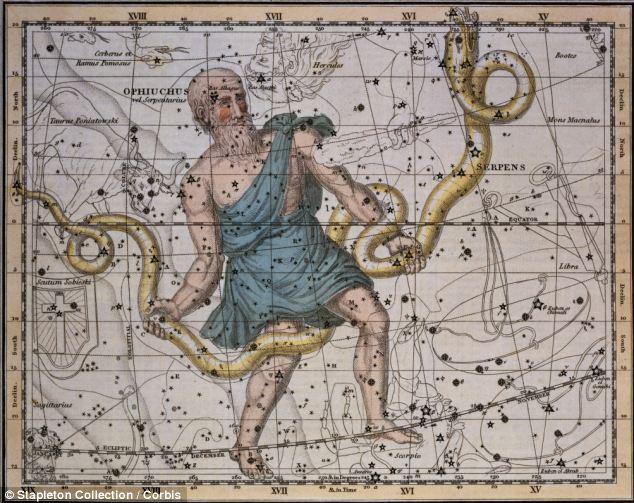
In a previous essay we have discovered strong evidence for an identification of Loki hiding in the disguise of a salmon below a waterfall with the constellation of the southern fish (Piscis Austrinus) located below the stream of water pouring out of the urn of the constellation Aquarius. Thor caught Loki and he was punished for his deeds by binding him with the entrails of one of his sons. This story is preserved In the Eddas in two versions:
Prose end of Lokasenna:
“He was bound with the bowels of his son Vali, but his son Narfi was changed to a wolf. Skathi took a poison-snake and fastened it up over Loki’s face, and the poison dropped thereon. Sigyn, Loki’s wife, sat there and held a shell under the poison, but when the shell was full she bore away the poison, and meanwhile the poison dropped on Loki. Then he struggled so hard that the whole earth shook therewith; and now that is called an earthquake.” (Bellows translation)
Gylfaginning 50:
"Now Loki was taken truceless, and was brought with them into a certain cave. Thereupon they took three flat stones, and set them on edge and drilled a hole in each stone. Then were taken Loki's sons, Váli and Nari or Narfi; the Æsir changed Váli into the form of a wolf, and he tore asunder Narfi his brother. And the Æsir took his entrails and bound Loki with them over the three stones: one stands under his shoulders, the second under his loins, the third under his knees; and those bonds were turned to iron. Then Skadi took a venomous serpent and fastened it up over him, so that the venom should drip from the serpent into his face. But Sigyn, his wife, stands near him and holds a basin under the venom-drops; and when the basin is full, she goes and pours out the venom, but in the meantime the venom drips into his face. Then he writhes against it with such force that all the earth trembles: ye call that 'earthquakes.' There he lies in bonds till the Weird of the Gods." (Brodeurs translation)
As we were able to identify the salmon-shaped Loki in the with the constellation of the southern fish we should assume that the story about his binding refers also to a group of constellations. As we found several of the foes of the gods in a certain area of the starry sky within the arch of the Milky Way (Fenris/Leo; Midgard serpent/Hydra; Surtr and his sword/Bootes and the star Arcturus) we should focus our search to this region of the sky. Taking into account that a serpent was placed upon his head the constellation of Ophiuchus, the serpent bearer, is attracting attention. Ophiuchus is located in between the two parts of the constellation of the serpent: the head of the serpent, Serpens Caput, and the tail of the serpent, Serpens Cauda. It is the only constellation of the ancient sky that consists of different, separated parts. It is tempting to compare this with the story of Narfi torn into pieces by his brother Vali. In the Greek and Roman astronomy we find different parts of a serpent and in the Teutonic myth with a son of Loki torn into pieces. In the Greek lore Ophiuchus is holding a serpent, in the Norse myth Loki is bound with serpent-like entrails.
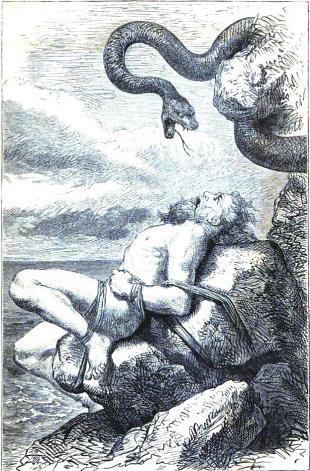
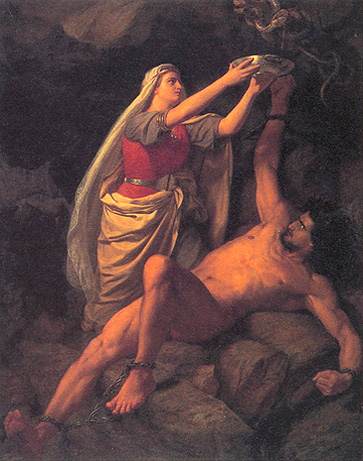
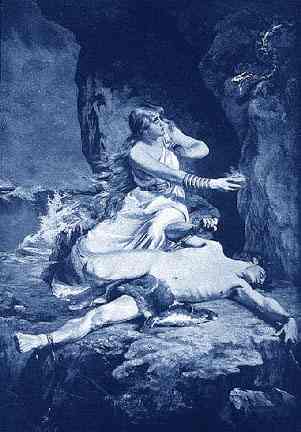
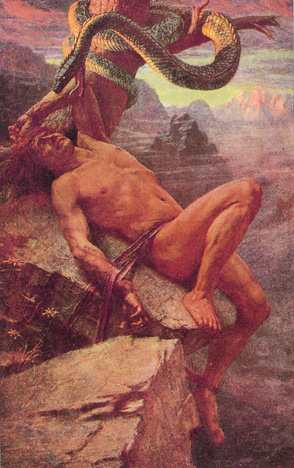
The identification of Loki with Ophiuchus can also explain the role of Skadi in this tale. Skadi is mentioned in Grímnismál as living in the abodes of her father Thiazi. If we identify Thiazi with the constellation Aquila, the eagle, than Skadi would be located exactly in the Milky Way above of Ophiuchus/Loki and the tail of the serpent (maybe seen here as a separate, living serpent). If we see the Milky Way as a chain of mountains surrounding the netherworld than Loki would be bound to the rocks of the mountains at the edge of the netherworld.
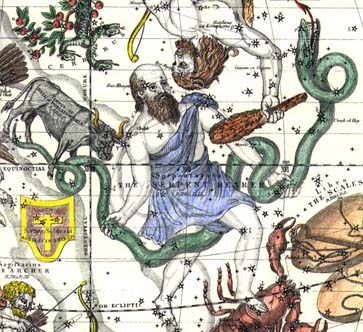
But if we find the bound Loki and the remains of
the torn son Vali, shouldn’t we find his other son Narfi, changed into a
wolf, as well? The answer could give a closer look to the constellation
Scorpio. On many drawings of the constellation it looks like a three
headed being, similar to the descriptions given for the hellhound of
Greek mythology, Cerberus. We therefore find a consistent group of star
constellations helping us to understand the tale of Loki’s binding till
he gets loose at the end of times.
The identification of Loki and Ophiuchus might get
an unexpected support from a totally different myth, the very strange
story about the abduction of an immobilized Loki by the giant Thiazi as
described in Skáldskaparmál 2: (Brodeurs translation)
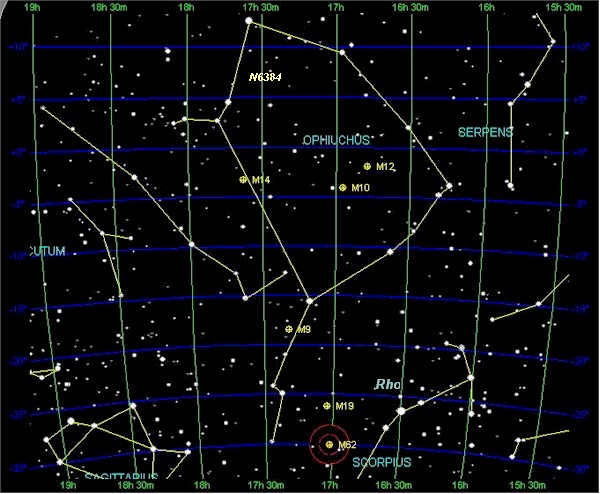
He began the story at the point where three of the Æsir, Odin and Loki and Hœnir, departed from home and were wandering over mountains and wastes, and food was hard to find. But when they came down into a certain dale, they saw a herd of oxen, took one ox, and set about cooking it. Now when they thought that it must be cooked, they broke up the fire, and it was not cooked. After a while had passed, they having scattered the fire a second time, and it was not cooked, they took counsel together, asking each other what it might mean. Then they heard a voice speaking in the oak up above them, declaring that he who sat there confessed he had caused the lack of virtue in the fire. They looked thither, and there sat an eagle; and it was no small one. Then the eagle said: "If ye are willing to give me my fill of the ox, then it will cook in the fire." They assented to this. Then he let himself float down from the tree and alighted by the fire, and forthwith at the very first took unto himself the two hams of the ox, and both shoulders. Then Loki was angered, snatched up a great pole, brandished it with all his strength, and drove it at the eagle's body. The eagle plunged violently at the blow and flew up, so that the pole was fast to the eagle's back, and Loki's hands to the other end of the pole. The eagle flew at such a height that Loki's feet down below knocked against stones and rock-heaps and trees, and he thought his arms would be torn from his shoulders. He cried aloud, entreating the eagle urgently for peace; but the eagle declared that Loki should never be loosed, unless he would give him his oath to induce Idunn to come out of Ásgard with her apples.
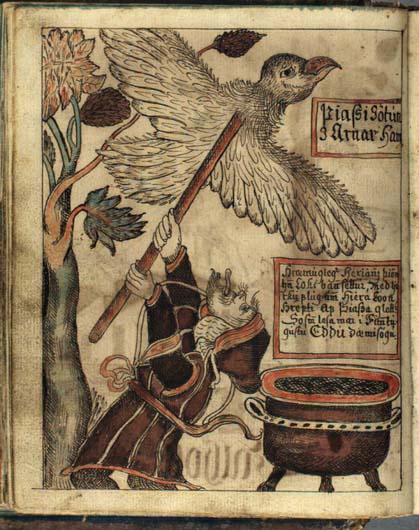
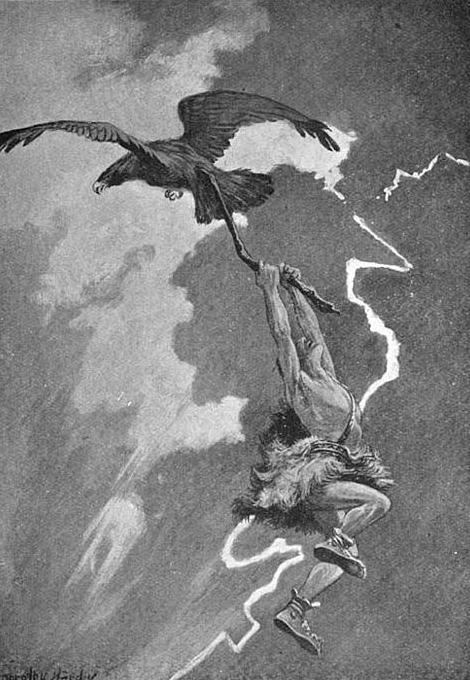
We therefore find surprisingly two very
different looking stories about Loki both leading to the same conclusion, an
identification of an immobilized Loki (in one case bound with entrails in the
other case sticking to a pole) with the constellation of Ophiuchus.